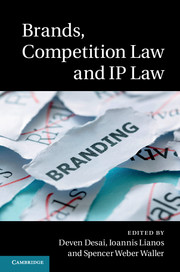Book contents
- Frontmatter
- Contents
- List of figures
- List of tables
- List of contributors
- Introduction
- PART I Brands, price theory and business studies' perspectives
- 1 An introduction to the competitive effects of branding
- 2 Bayer or Walgreen's? The relationship of premium and value brands in the United States
- 3 The value of brands and the challenge of free-riding
- PART II Brands and competition law
- PART III Brands and IP law
- Index
- References
1 - An introduction to the competitive effects of branding
from PART I - Brands, price theory and business studies' perspectives
Published online by Cambridge University Press: 05 August 2015
- Frontmatter
- Contents
- List of figures
- List of tables
- List of contributors
- Introduction
- PART I Brands, price theory and business studies' perspectives
- 1 An introduction to the competitive effects of branding
- 2 Bayer or Walgreen's? The relationship of premium and value brands in the United States
- 3 The value of brands and the challenge of free-riding
- PART II Brands and competition law
- PART III Brands and IP law
- Index
- References
Summary
Brands allow businesses to reach consumers directly with messages regarding emotion, identity, and self-worth such that consumers are no longer buying a product but buying a brand.
Introduction
The purpose of this chapter is to provide a brief review of the economics of the competitive effects of branding. Since Marshall (1890, 1919), economists have thought about at least two roles that brands can play, one largely positive the other potentially negative:
1. Informing and Signalling: Brands may convey information about a product's price or quality to consumers. As such branding may involve choice of names, terms, symbols and designs which signal the quality of the goods of a particular seller and thereby attempt to differentiate them from those of its competitors. Customers may recognize a brand even when they know little about the product.
2. Persuading: Branding may seek to persuade customers to buy a product that they would not have otherwise purchased; branding may seek to create new demand.
In terms of the first role, consider, for example, an experience good, such as a new shampoo, where the quality of the product can only be observed after purchase. For such products, a brand may indicate to consumers that a new product is of high quality. Another example is provided by the franchising literature, which seeks to understand why, for example, potential entrepreneurs pay to open a Subway or McDonalds store rather than open an independent restaurant. One reason may be that the brand signals that products will satisfy a minimum quality – such minimum quality levels will be enforceable since they will form a part of the contract between franchisee and franchisor. The result is that customers know that products purchased from outlets with which they do not have experience will not be too different from the products sold by those with which they do. The brand signals a minimum quality, in this case across locations.
In terms of the second role, the potential persuasive effect of advertising has long been a source of concern to both policymakers and economists. Economists would typically welcome an outcome where a customer is persuaded of the merits of a good because it fits with her wants.
- Type
- Chapter
- Information
- Brands, Competition Law and IP , pp. 13 - 24Publisher: Cambridge University PressPrint publication year: 2015



